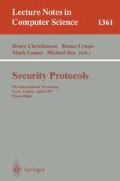Abstract
In this paper we show, that the elliptic curve cryptosystem by Menezes and Vanstone is not really a probabilistic cipher, in contrast to its design. Each ciphertext leaks some kind of information, which could be used for unauthorized decryption, if the cryptosystem is set up in a careless way. But in any case we have a loss of efficiency, since the additional effort, which always comes with probabilistic encryption, does not pay.
Author is member of research group of Prof. J. Buchmann, who moved to Technische Hochschule Darmstadt. Graduiertenkolleg Informatik is granted by Deutsche Forschungsgemeinschaft (DFG).
Preview
Unable to display preview. Download preview PDF.
References
D. Coppersmith. Fast Evaluation of Discrete Logarithms in Fields of Characteristic Two, IEEE Transactions of Information Theory IT-30 (1984), pp. 587–594.
T. ElGamal. A Public Key Cryptosystem and a. Signature Scheme Based on Discrete Logarithms, IEEE Transactions on Information Theory, 31 (1985), pp. 469–472.
N. Koblitz. A Course in Number Theory and Cryptography, New York, 1987.
U. Maurer, S. Wolf. Diffie-Hellman-Oracles, Advances in Cryptology-CRYPTO'96 Proceedings, pp. 268–282.
K. McCurley. The Discrete Logarithm Problem, Cryptology and Computational Number Theory, AMS Proc. Symp. in Applied Mathematics, 42 (1990), pp. 49–74.
A. Menezes, S. A. Vanstone. Elliptic Curve Cryptosystems and Their Implementation, Journal of Cryptology, 6 (1993), pp. 209–224.
A. Odlyzko. Discrete Logarithms and their Cryptographic Significance, Advances in Cryptology-EUROCRYPT'84 Proceedings, pp. 224–314.
S. Pohlig, M. Hellman. An Improved Algorithm for computing Logarithms over GF(p n) and its Cryptographic Significance, IEEE Transactions of Information Theory, 24 (1978), pp. 106–110.
C. E. Shannon. Prediction and Entropy in Printed English, Bell System Technical Journal, 30 (1951), pp. 50–64.
D. R. Stinson. Cryptography: Theory and Practice, Boca Raton, 1995.
D. Weber, T. Denny, J. Zayer. Discrete Log Record, posting to Number Theory Net (NMBRTHRY@listserv.nodak.edu), November 25, 1996.
Author information
Authors and Affiliations
Editor information
Rights and permissions
Copyright information
© 1998 Springer-Verlag Berlin Heidelberg
About this paper
Cite this paper
Kiefer, K. (1998). A weakness of the Menezes-Vanstone cryptosystem. In: Christianson, B., Crispo, B., Lomas, M., Roe, M. (eds) Security Protocols. Security Protocols 1997. Lecture Notes in Computer Science, vol 1361. Springer, Berlin, Heidelberg. https://doi.org/10.1007/BFb0028170
Download citation
DOI: https://doi.org/10.1007/BFb0028170
Published:
Publisher Name: Springer, Berlin, Heidelberg
Print ISBN: 978-3-540-64040-0
Online ISBN: 978-3-540-69688-9
eBook Packages: Springer Book Archive

